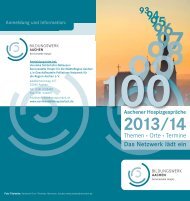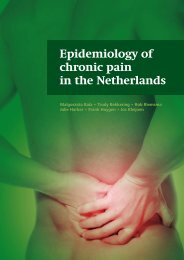First EFIC® Symposium Societal Impact of Pain - SIP
First EFIC® Symposium Societal Impact of Pain - SIP
First EFIC® Symposium Societal Impact of Pain - SIP
You also want an ePaper? Increase the reach of your titles
YUMPU automatically turns print PDFs into web optimized ePapers that Google loves.
Jose De Andrés<br />
Pr<strong>of</strong>. Jose De Andrés MD, PhD, FIPP<br />
Qualified from the School <strong>of</strong> Medicine <strong>of</strong> the<br />
Valencia University.<br />
Current Positions and responsibilities:<br />
• Associate Pr<strong>of</strong>essor <strong>of</strong> Anaesthesiology <strong>of</strong><br />
the Valencia University School <strong>of</strong> Medicine.<br />
• Chairman <strong>of</strong> Anaesthesia , Critical Care and<br />
<strong>of</strong> the Multidisciplinary <strong>Pain</strong> Management<br />
Departments in the Valencia University General<br />
Hospital (Valencia, Spain).<br />
• European Society <strong>of</strong> Regional Anesthesia and<br />
<strong>Pain</strong> Therapy (ESRA): Treasurer, member <strong>of</strong><br />
the scientific committee and councillor <strong>of</strong><br />
Spain in the board <strong>of</strong> directors.<br />
• European Federation <strong>of</strong> IASP Chapters (EFIC):<br />
Councillor <strong>of</strong> Spain in the European council.<br />
• Spanish <strong>Pain</strong> society (IASP Chapter): Director<br />
<strong>of</strong> continuous medical education programme<br />
• President <strong>of</strong> “Foundation for study and treatment<br />
<strong>of</strong> pain <strong>of</strong> the Valencian community”<br />
Member on editorial boards <strong>of</strong> national and<br />
international journals in the field <strong>of</strong> Regional<br />
Anaesthesia and <strong>Pain</strong> Medicine<br />
Scientific Activity: publications, chapters and<br />
collaborations in books specializing in conferences<br />
oral presentations and research lines<br />
relating to pain management.<br />
Interventional therapeutic strategies for<br />
the treatment <strong>of</strong> pain<br />
The management <strong>of</strong> patients suffering from<br />
chronic pain has proven to be a complex<br />
process. Interventional and surgical techniques<br />
should be considered when pharmacological<br />
treatment supplemented with physical exercise<br />
failed to provide adequate relief or induced unacceptable<br />
side effects.<br />
There are a multitude <strong>of</strong> interventional techniques<br />
in the management <strong>of</strong> chronic pain, in-<br />
cluding not only neural blockade but also minimally<br />
invasive surgical procedures such as peripheral<br />
nerve blocks, trigger-point injections,<br />
epidural injections, facet joint injections, sympathetic<br />
blocks, neuro-ablation techniques, intradiscal<br />
thermal therapy, disc decompression,<br />
vertebral reinforcement techniques like kyphoplasty,<br />
morphine pump implantation, and spinal<br />
cord stimulation.<br />
The epidural administration <strong>of</strong> corticosteroids,<br />
either by the interlaminar or transforaminal<br />
route, allows precise application <strong>of</strong> corticosteroids<br />
to the vicinity <strong>of</strong> the irritated nerve<br />
root, resulting in massive concentration <strong>of</strong> the<br />
agent at the site and its therapeutic effect for<br />
the management <strong>of</strong> spinal pain has been investigated.<br />
Radi<strong>of</strong>requency (RF) techniques in the management<br />
<strong>of</strong> different chronic pain syndromes is<br />
based on interference in the conduction <strong>of</strong><br />
nociceptive stimuli. The electric field generated<br />
around the electrode has the potential <strong>of</strong> producing<br />
modification <strong>of</strong> neural structures and<br />
neuronal behavior, which may also change pain<br />
perception. Pulsed radi<strong>of</strong>requency (PRF) was<br />
introduced in clinical practice as a non- or minimal<br />
neurodestructive modification <strong>of</strong> conventional<br />
RF heat lesions.<br />
Improvements in the understanding <strong>of</strong> Intrathecal<br />
drug delivery (IDD) and the drive for<br />
higher standards in implantation procedure,<br />
combined with advances in technology and use<br />
<strong>of</strong> novel drug combinations <strong>of</strong> drugs such as<br />
bacl<strong>of</strong>en and morphine or clonidine contribute<br />
to successful treatment outcomes with IDD.<br />
Spinal cord stimulation, also referred to as<br />
SCS, has been applied successfully in a number<br />
<strong>of</strong> indications, but is most <strong>of</strong>ten used to treat<br />
postoperative neuropathic back and leg pain,<br />
most commonly called failed back surgery syndrome<br />
(FBSS), and complex regional pain syndrome<br />
(CRPS); The efficacy <strong>of</strong> SCS in CRPS<br />
and FBSS/CLBP has resulted in the technique<br />
being used in other pain states, such as diabetic<br />
neuropathy, post-traumatic neuralgia and<br />
postherpetic neuralgia. Current applications <strong>of</strong><br />
electrical neuromodulation implies its use at<br />
periferal nerves but also in field stimulation indications.<br />
With all these possibilities interventional pain<br />
procedures must be carefully selected and applied<br />
for achieving the best care for our patients<br />
and providing at the end intended quality<br />
<strong>of</strong> life.<br />
25






